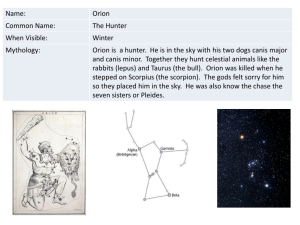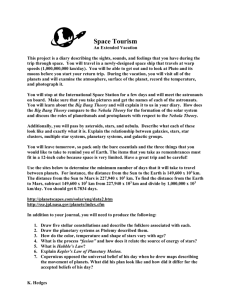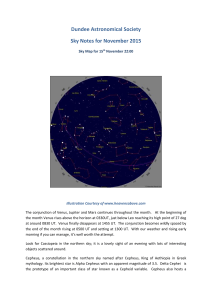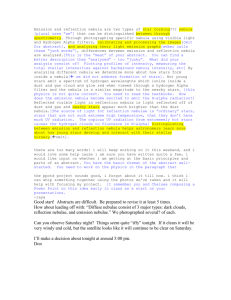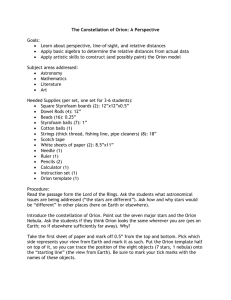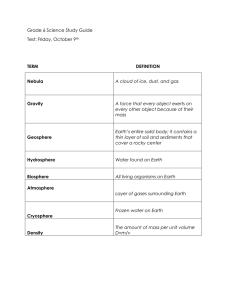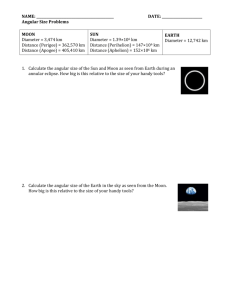The Orion Nebula (M42)
advertisement
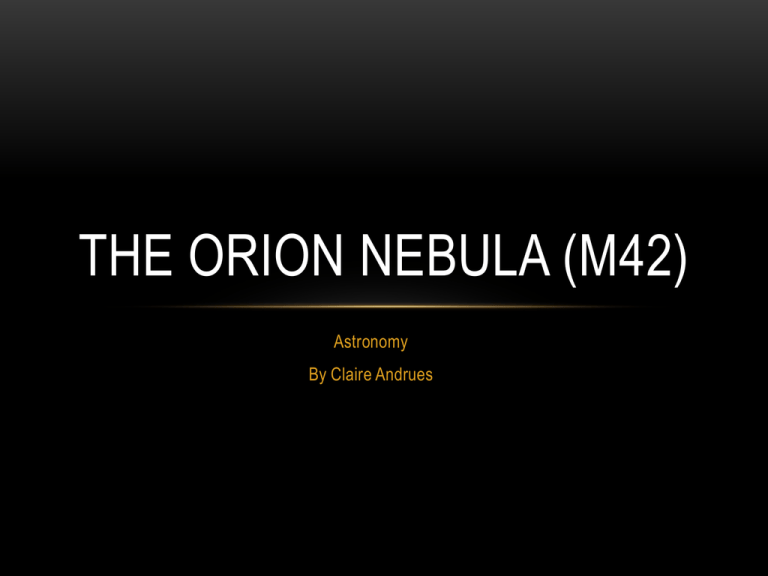
THE ORION NEBULA (M42) Astronomy By Claire Andrues WHERE IS IT LOCATED IN OUR SKY? • The Orion Nebula is located in the constellation Orion. It can be located with the naked eye by first finding Orion’s belt, a visible curved path of three stars, and then finding the two stars Betelgeuse and Rigel, which are among the brightest stars in our sky. Find the midpoint between the stars and then look under the belt of Orion. The Orion nebula is close to earth, which makes it a visible fluffy ball in our night sky. WHERE IS IT LOCATED IN SPACE? • The Orion nebula is located, like Earth, in the Milky way Galaxy. The Orion nebula is very close to Earth compared to other objects in the constellation Orion. While the star Betelgeuse is 640 light years away and the star Rigel is 800 light years away, the Orion Nebula is only 35 light years away from Earth. Its close proximity makes it one of the only nebulas that the human eye can examine in the sky. WHAT IS A NEBULA? • A nebula is an interstellar cloud of dust in space. It contains hydrogen, helium, and other gases. A nebula is a region where stars are born. Gases and space dust come together under a gravitational collapse and form large masses. These new masses attract other matter in space and eventually form stars like our Sun. THE ORION NEBULA • The nebula is about 24 light years across and is 2000 more times massive then the mass of our sun. It is at least two million years old and has been creating stars for that same amount of time. The Orion nebula is still active today. Loose clusters of 700 newly formed stars are seen in the nebula. • Stars that are thought to have formed in the Orion nebula from two million years agao include: AE Aurigae, 53 Arietis and Mu Columbae • Stars that are very young in the nebula are the open cluster Trapezium, which contains four main stars, two of which are binary systems which contain two more stars equaling six in the cluster. HISTORY • The Orion Nebula can be seen in the night sky with a sharp eye and so its discovery goes far back in our history. • The Mayans are thought to have noticed the nebula and use it in stories such as their “Three Hearthstones” myth that compared the nebula to the area of Orion’s belt. • It is not known whether Early Astronomers such as Ptolemy and Galileo noticed the nebula because it is not mentioned in any of their writings about the sky. • The first recorded observation on the nebula was by Nicolas-Claude Fabri de Peiresc, a French astronomy in 1610 using a refracting telescope. • Later the first publication was by Johann Baptist Cysat in 1619 Nicolas-Claude FIRST PHOTOGRAPH • In 1880 Henry Drape, a professor in Astronomy, captured the first photograph of the Orion Nebula. • The photograph is overexposed and shows the surrounding stars much brighter than the nebula. SO MANY COLORS • Like many other nebulae, M42 has areas of red and blue-violet coloration. The visible red is created by a hydrogen emitted wavelength, while the blue is created by the reflected radiation from O-class stars found in the nebula. • The difference in the Orion Nebula from others is the large amount of green coloration. In the early 20th century when not many other nebulae had been observed by astronomers. The green color was thought to be a new unknown element. Spectral lines had not been distinguished and so the color could not be identified. • It is now known that the green spectral lines come from an electron transition in ionized oxygen that is considered “low-probable” THE ORION NEBULA SOURCES • http://earthsky.org/clusters-nebulae-galaxies/orion-nebula-jewel-in-orions-sword • http://blog.astrophotographytargets.com/2011/09/m42m43-orion-nebula/ • http://en.wikipedia.org/wiki/Orion_Nebula • http://www.educatedearth.net/viewer.php?id=5919&cid=49
![Orion's_Nebula[1]](http://s2.studylib.net/store/data/010164075_1-f72c41f52afb208225de67e18e05f3bb-300x300.png)
